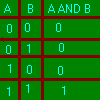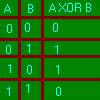
April 7th, 2001
 |
Issue #3 April 7th, 2001 |
Advanced math vs. programming
Many people think that you need to be a wizard at math to be a
programmer. This is a common misconception, and the QB
community (with people of ages ranging from 12 to 19) is the perfect
example to show that the above is a
stereotype. The question: how much math do you actually need to do
programming? What about the amount of math needed to program different
levels of programming language? (think QB vs. C++ vs. ASM)
To answer these questions, it is imperative that we look at the
programming. Being more experienced in QB programming, I'll talk in
terms of QB
programming first.
In simple QB programming, all you need is to know how addition,
subtraction, multiplication, division and parenthesizes (in short,
brackets) work, and to
take note of the order of precedence of these arithmetic calculations.
You don't even have to calculate the numbers. That's because the
computer does
all the mental madness itself. You can give it 29644 *12334 +12123
-12422 / 2354, and it spits the correct answer out every time, even
taking in account
the performance of the multiplication and division before the
performance of addition and subtraction. To calculate the above
statement with pencil and
paper would be a rather tedious job, and you should be glad that the
computer is there to calculate it. So, in terms of arithmetic, you only
need
to know you very basics. A fourth or fifth grade standard in math would
do.
A rather basic knowledge
of algebra is also needed by the beginner. Your
variables are the algebra symbols in many ways. It should suffice to
say that without a background knowledge in the application and
usefulness of
algebra, it's going to be almost impossible to accept variables, even
in QB programming where many things are simplified for you.
Apart from algebra, a good mathematical knowledge in number types is
also recommended. From your math, you should know what is an integer
and how it
refuses to take in decimal numbers, preferring instead to round the
number off to the nearest whole number (as a side note, please note
that in math,
your integers don't have a numerical boundary whereas in QB, your
integers
are bound between -32768 to 32767 inclusive. QB, and probably many
other programming language's integers are bound like this so that they
fit into 2
bytes of space). Know your decimal number system by hard. Since this is
QB, you don't really need to know your binary (base 2) and hexadecimal
(base 16)
number systems, at least before you reach the advanced portions of
programming. You don't need to know the octal (base 8) system either.
You
would have to be experienced in hexadecimal number system if you fiddle
with ASM though. An understanding in binary is strongly encouraged to
understand
the technical stuff such as your data storage and management (for
example, how the computer performs arithmetic in binary form quickly).
I don't know
how the octal system came about, so I'm not used to base 8 numbers. I
don't think any aspiring programmers need to know the octal number
system now.
A more abstract part of mathematics is needed in slightly more complex
areas of programming in QB: logical operators. Logical operators, in
case you do
not know, are your ANDs, ORs, XORs, NOTs and so on; those things that
you use in your IF statements (there are more obscure logical operators
such as
IMP, EQV, NAND and so on, but nobody uses them, so they are not
discussed)
This is not really taught in schools in math lessons. Rather, you
should understand this separately as a math concept first, than apply
it to your
programming. One way to understand logical operators is to just explain
them in English, as in "AND means that both conditions must be true for
the
result to be true" or "XOR means that both conditions are true or all
conditions are false, the result is false", but a more professional and
standard way to express them is through truth tables. Truth tables are
tables plotted for all combinations of the truth of both conditions. In
case
you do not know what I am talking about, below are two truth tables,
one for AND and one for the obscure XOR, where "0" represents a false
condition and
"1" represents a true condition:


As you can see, the illustration of logical operators with the help of truth tables really help.
As for trigonometry, one of my most disliked aspects of mathematics,
good news for you: unless you are programming some kind of graph
program or some
unimaginable application, you usually won't need to touch trigonometry
at all. The same goes with calculus, which is another section of math
which I
disliked.
The highest order of mathematics: "logic", cannot be forcefully taught.
You can only pick it up through experience. This is the most important
part of
programming, and this is the part which most successful programmers are
rich in. Logic differs from logical operators because logic is much
more
difficult and much broader than logical operators. Logic is the thing
in mathematics that allow you to think of proofs in the math field, and
algorithms in the programming field. This applies to QB, and even more
in
other lower level programming languages, like C and ASM. Logic is the
thing that separates good programs and bad programs. In some ways,
logic is our
so-called "common sense", but logic is even more than common sense;
logic is common sense used actively.
All in all, remember the crux of this rant: you don't really need
advanced math to program, at least in QB. A high school grade is
enough. So if you
have a younger friend or brother (or even yourself) who is thinking
about programming, go on. There is always room for improvement, and you
don't need
many mathematical skills to start programming.
If you wish to read more articles like this, please visit http://qbtalk.zext.net/
This article was written by: Singsong - http://qbtalk.zext.net
| All site content is © Copyright 2001, HyperRealistic Games. This excludes content submitted by other people. |